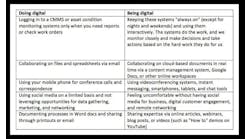By David Yanez, founder and CEO of Andonix
The global economy has been fundamentally transformed by the COVID-19 pandemic. While millions have taken to working from home, 75% of US workers hold jobs that cannot be done remotely. Even further, 25 million front-line employees work tirelessly to keep our supply chains, energy grid, essential services, and infrastructure operating and the economy running.
Manufacturers of all sizes are scrambling for answers, asking How do we reopen, and more importantly, how do we stay open?
There is no going back to “normal” until a vaccine is ready for the novel coronavirus, and it could be months or even years before that happens.
So we consider a new normal, which is more than just a new way of thinking about work. It’s also the rapid transformation of how front-line workers operate. It’s about new health-management systems and processes to prevent outbreaks.
Due to the lack of existing solutions and limited resources, preventing an outbreak has become the greatest challenge faced by many companies in the process of reopening and staying open. Let’s take a closer look at the key initiatives that must be addressed so our front-line manufacturing workers remain safe as our economy reopens.
Detecting potential infection
The first step in establishing a new normal for front-line operations is detection. Companies are turning to temperature monitoring and testing. Local and state governments, including New York City and Michigan, are starting to implement regulations that allow businesses to require temperature checks on employees and visitors before entering the premises.
These contact-free temperature checks and any visual observation of overt symptoms, combined with digital self-reporting of any potential exposure or symptoms, helps reduce the risk of spreading the virus.
Preventing the spread of infection
In addition to wellness-monitoring and testing, it’s important to have a robust prevention program in place, including physical distancing of employees and the use of proper personal protective equipment (PPE).
Site-entry must be carefully managed to avoid clusters of people. Staggering entry and exit periods by redesigning traditional shift times, implementing a touchless-entry process, and limiting the number of entrances can all help with this.
Inside the facility, social-distancing procedures must keep employees six feet from one another as often as possible, and implement the use of faceguards and masks if they are any closer. All forms of physical contact should be entirely eliminated, and external guests should be limited to those who are vital to operations. The continued use of digital-meeting platforms to eliminate in-person meetings is also highly recommended.
Monitoring operations to allocate resources
The third pillar for successful containment is monitoring. Data can help predict, prevent and prescribe the right plan for front-line workers. Additionally, it’s important to allocate resources where they are needed most, and technology can help establish viable and executable plans that adjust to evolving conditions. These include increasing disinfection processes at strategic locations, prioritizing testing based on key risk factors, eliminating touchpoints that are sources of potential infection, and guiding people to exercise physical distancing effectively.
Technology’s role in keeping your doors open
Fully modernizing front-line manufacturing operations to account for the new normal can be a complex process. Only through the power of data and digitization are many companies going to be able to scale these efforts and get ahead of potential infection.
Technology can help implement systematic, effective and scalable health-containment initiatives. With the right automation and integration processes, organizations can seamlessly embed effective initiatives and better address risks to avoid shutting down again in the future.

